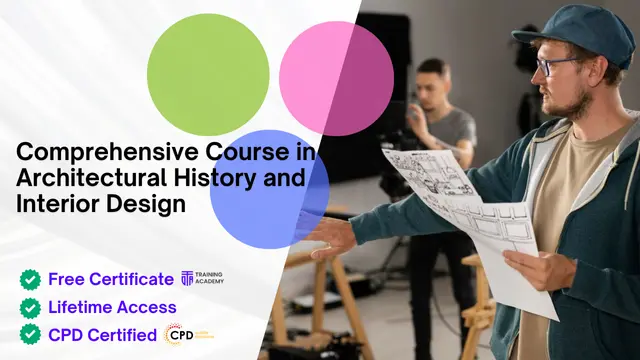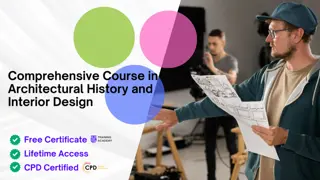
Comprehensive Course in Architectural History and Interior Design
CPD Accredited ! Free Certification | FREE Retake Exam | Lifetime Access | No Hidden Fees
Summary
- Digital certificate - Free
- Reed Courses Certificate of Completion - Free
- Tutor is available to students
Add to basket or enquire
Overview
Take on a journey through Architectural History and Interior Design is akin to opening a door to a realm where creativity meets functionality, where spaces tell stories, and where every corner whispers a narrative. In today's modern world, this course holds paramount importance, serving as a gateway to understanding the evolution of structures and the art of crafting environments that resonate with human emotions.
Delving into Scandinavian Architectural Style, Eclecticism, Art Deco, and more, you'll master the language of design, learning to orchestrate spaces with finesse. From the play of lighting in Interior Design to the nuances of color psychology, every module enriches your palette of skills. This knowledge isn't just confined to the realm of aesthetics; it permeates into our daily lives, enhancing functionality and fostering well-being.
Moreover, in the professional arena, the demand for Interior Designers is burgeoning, with ample opportunities awaiting in the UK job market. With a refined skill set, you could secure positions commanding competitive salaries, with the average ranging from £25,000 to £45,000 per annum, depending on expertise and experience. The advantages of this course are manifold, offering a blend of artistic expression and practical prowess. As the sector continues to expand, with an approximate growth rate of 4-6% annually, honing your skills in Architectural History and Interior Design is not just a choice, but a strategic investment in a flourishing career path.
Key Features
This Comprehensive Course in Architectural History and Interior Design Includes:
- This Architectural History and Interior Design Course is CPD Accredited
- Free Certificate from Reed
- Developed by Specialist
- Lifetime Access
Certificates
Digital certificate
Digital certificate - Included
Reed Courses Certificate of Completion
Digital certificate - Included
Will be downloadable when all lectures have been completed.
CPD
Curriculum
Course media
Description
Course Curriculum
Architectural History and Interior Design
- Module 01: Introduction to Architectural Studies
- Module 02: Architectural Styles Overview
- Module 03: Baroque and Rococo Architecture
- Module 04: Classical and Early Christian Architecture
- Module 05: Gothic Architecture
- Module 06: Scandinavian Architectural Design
- Module 07: Victorian Architecture
- Module 08: Modern and Post-Modern Architecture
- Module 09: Interior Design Fundamentals
- Module 10: Eclectic Architectural Design
- Module 11: Art Deco Architecture
- Module 12: Architectural Ideas and Movements
- Module 13: Colour Theory in Interior Design
- Module 14: Lighting Design for Interiors – Part One
- Module 15: Lighting Design for Interiors – Part Two
- Module 16: Ancient Architecture
Learning Outcomes:
After completing this Architectural History and Interior Design Course, you will be able to:
- Analyze architectural styles to inform design decisions effectively.
- Apply lighting techniques to enhance interior spaces aesthetically.
- Interpret historical influences on contemporary design practices accurately.
- Evaluate the impact of color schemes on spatial perception and mood.
- Synthesize diverse architectural ideas into cohesive design concepts.
- Communicate architectural concepts visually and verbally with clarity.
Who is this course for?
This Architectural History and Interior Design course is accessible to anyone eager to learn more about this topic. Through this course, you'll gain a solid understanding of Architectural History and Interior Design. Moreover, this course is ideal for:
- Aspiring architects seeking a comprehensive understanding of architectural history.
- Interior designers looking to broaden their design repertoire.
- Students passionate about art, history, and design.
- Professionals in related fields eager to expand their knowledge.
- Anyone with a keen interest in the built environment and its evolution.
Requirements
There are no requirements needed to enrol into this Architectural History and Interior Design course. We welcome individuals from all backgrounds and levels of experience to enrol into this Architectural History and Interior Design course.
Career path
After finishing this Architectural History and Interior Design course you will have multiple job opportunities waiting for you. Some of the following Job sectors of Architectural History and Interior Design are:
- Architectural Technician - £20K to 35K/yr
- Interior Designer - £22K to 45K/yr
- Architectural Historian - £25K to 40K/yr
- Lighting Designer - £24K to 50K/yr
- Design Consultant - £22K to 40K/yr
Questions and answers
Currently there are no Q&As for this course. Be the first to ask a question.
Reviews
Currently there are no reviews for this course. Be the first to leave a review.
Provider
Online Training Academy: Your Premier Destination for High-quality Online Courses.
Online Training Academy is a premier provider of online education, dedicated to empowering individuals and businesses through high-quality, CPD-accredited training programs. Established by a team of industry experts, we offer a diverse range of courses designed to enhance professional skills and organisational performance across various sectors.
At Online Training Academy, we are dedicated to transforming the way individuals access education and enhance their skills. Whether you are looking to enhance your professional skills, explore new hobbies, or achieve academic excellence, our diverse course offerings have you covered. We are chosen by over 200,000 students and partnering with 2,000 businesses globally.
How Are We Different?
- 200,000+ Students
- 2,000 Business Partners
- 3,000+ CPD Accredited Courses
At Online Training Academy, we develop interactive video-based online courses tailored to meet the critical training needs essential for business success.
Our Corporate Training Offerings:
- Any time course access from any device
- Dedicated Business Dashboard
- Reporting & User Management
- Instant Certification & Validation
- 24/7 Tutor Support & Customer Service
- Competitive Pricing
Accreditations and Memberships:
- CPD Quality Standards Accredited
Legal information
This course is advertised on Reed.co.uk by the Course Provider, whose terms and conditions apply. Purchases are made directly from the Course Provider, and as such, content and materials are supplied by the Course Provider directly. Reed is acting as agent and not reseller in relation to this course. Reed's only responsibility is to facilitate your payment for the course. It is your responsibility to review and agree to the Course Provider's terms and conditions and satisfy yourself as to the suitability of the course you intend to purchase. Reed will not have any responsibility for the content of the course and/or associated materials.

